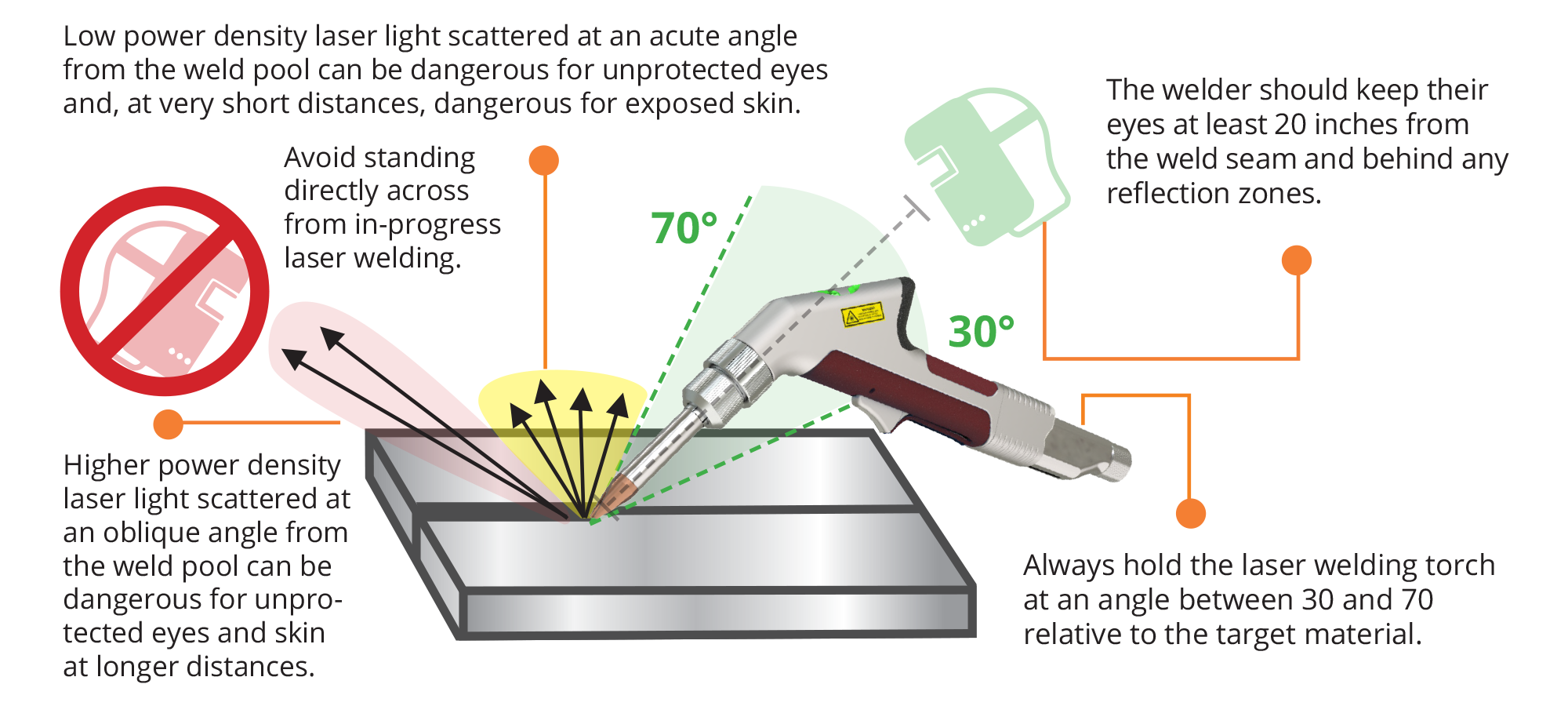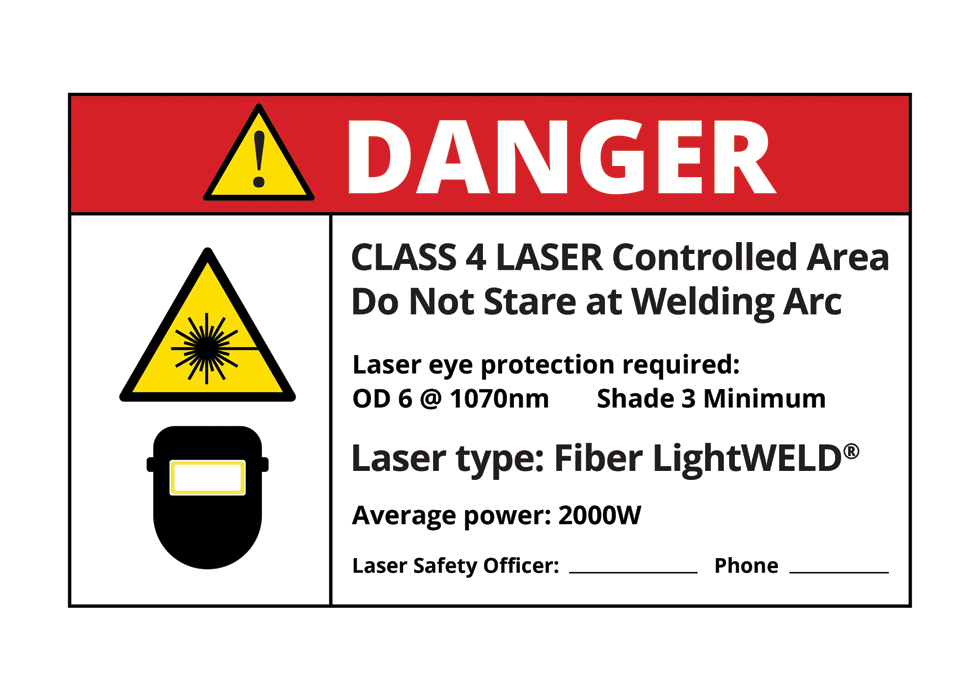With the availability of new portable air-cooled handheld laser welding systems, interest in laser welding has been rapidly increasing over the past few years. It’s not hard to see why: laser welding is easy to learn, produces excellent quality welds quickly and efficiently, and minimizes post-weld finishing work. The benefits for businesses and welders are significant.
But there’s a common question: what about safety? In the fabrication industry, traditional methods like MIG and TIG are well understood. Experienced welders know to wear heat-resistant clothing, use eye protection, and limit their exposure to fumes. Handheld laser welding, on the other hand, is still new to many fabricators and not yet as well understood.
Fortunately, there is a lot of overlap between the precautions used for both arc welding and laser welding. But there are some key differences too. In this article we’ll take you through everything you need to know (and a little bit more).
Is Laser Welding Safe?
There is a good chance that you’re here for a simple yes or no answer to that question. The short answer is yes, provided you follow a few guidelines. The long answer is, well, the rest of this article.
Laser welding has been employed in a variety of applications and industries for decades. Continuous improvements in laser technology have led to increased adoption – so much so that you probably come across laser welded products almost every day. Everything from vehicles to batteries and from electronics to jewelry often rely on the precision and quality of laser welding.
None of this would be possible, of course, if lasers and laser safety were not well understood. Let’s start by examining how laser light works.

Lasers can emit light across a wide range of wavelengths (often measured in nanometers). The fiber lasers used for handheld welding emit infrared light with a wavelength of roughly 1070 nanometers. This infrared light is not visible to the naked eye, but it can still present a problem if it makes direct or indirect contact with unprotected eyes or skin.
The wavelength of laser light impacts how much of it is absorbed and how much is reflected by any given material. 1070 nanometer light is absorbed well by most metals but some is still reflected.
Absorbed laser light is rapidly converted to heat to form a molten weld pool. Reflected laser light is scattered away from the target material. Once reflected and scattered, the relative power density of the beam quickly decreases as it travels further from the torch. In other words, there’s little chance of damaging non-flammable materials on the other side of the room. Still, it pays to be careful.

When laser welding, always hold the torch at an angle between 30° and 70° from the surface being welded and always point the torch away from yourself. Higher angles risk damaging the torch’s optics or reflecting light at the welder. Lower angles send more concentrated light away from the part (and will likely impact weld quality). Regardless of the angle used, it’s important to remember that nobody should ever stand directly in front of someone who is laser welding.
The welding area must also be secured with reflections in mind. This means taking the normal steps to ensure no flammable materials are nearby or are sufficiently protected. And, in the case of laser welding, it also means ensuring there are no highly reflective or sensitive materials close by and directly in the path of reflections.
Personal Protection for Laser Welding
As is the case with arc welding, PPE is a cornerstone of safety for laser welding. Here’s what you will need.
Laser Safety Eyewear: Unprotected viewing of the beam, reflected or otherwise, should be avoided. While welders already know not to look directly at welding arcs, the relative intensity of laser light is much higher. The bare minimum for anyone with direct or indirect line of site to the laser beam is laser safety glasses or goggles.
Laser safety glasses protect your eyes by blocking certain wavelengths of light while allowing others to pass through as normal. There’s no such thing as laser safety glasses that work for every wavelength and intensity – for handheld laser welding you are looking for an Optical Density (OD) of 7+ and protection from a range of wavelengths that includes 1070 nm.
It is worth noting that standard laser safety glasses offer limited protection from the bright visible light produced by laser welding. That means that observers with safety glasses should avoid looking directly at the light for extended periods of time. Fortunately, welders (who can’t exactly look away) are further protected from visible light by laser welding helmets.
Laser Welding Helmet: Welders must also wear a welding helmet designed for laser welding. Laser welding helmets include lenses that reflect and/or absorb infrared laser light alongside traditional lenses that protect against UV and visible light.
It is critical to understand that laser welding helmets are not suitable for arc welding. Similarly, arc welding helmets are not suitable for laser welding.
Wearing both a laser-safe welding helmet and laser safety glasses helps ensure the welder has multiple layers of protection. And, like any welding helmet, laser welding helmets protect welders from sparks, heat, and impacts.
Appropriate Clothing: The range at which skin damage can occur is much less than the range at which eye damage can occur, but lasers can still cause burns and irritation to exposed skin. Your choice of clothes should protect against accidental exposure to reflected laser light and more common hazards like still-hot parts and welding sparks.
Fortunately, clothes that work for arc welding work just as well for laser welding. You’re covered if you wear heat-resistant clothing that covers all exposed skin. As usual, stay away from synthetic fabrics or plastics.
Respirators: Respirators are optional, depending on the welding environment. If there is sufficient air flow, ventilation, or a fume extraction system, then a personal respirator may not be required. Otherwise, welders should take precautions against both particulates and gases (as is the case with any type of welding).
Enclosures & Laser Controlled Areas
At the laser powers commonly used for handheld laser welding, there is a chance of eye damage up to hundreds of feet away. Although laser safety glasses offer protection for passersby, it is not practical or safe to expect that everyone in the area wear them at all times.
As a result, laser welding workspaces require what is known as a Laser Controlled Area. Laser Controlled Areas are designated spaces in which precautions are taken to protect individuals from the potential hazards of laser light.
Here’s an overview of what you will need to consider when protecting your workspace.
Enclosures: Non-handheld laser processing systems are often integrated with an enclosure built to prevent exposure to laser light. The same is not true with handheld laser devices. So, what are your options?
There are a variety of approaches and the best one for you depends on your workspace. Standalone barriers, curtains, existing walls, and anodized aluminum panels all can work. Ultimately, barriers must be rated safe for use with Class 4 lasers up to the laser’s wattage and the enclosure should be as “light tight” as possible.
Enclosures do not necessarily require dedicated roofs and are not usually required to reach the ground, although they may if workers and passersby are likely to have line of sight from above or below. For example, a roof may be necessary if your workspace has a 2nd story walkway like a mezzanine or gangway.
Safety Interlocks: Automated laser systems often utilize interlocked access doors to prevent operators from accidentally opening the system while the laser is on. Safety interlock interfaces are built into reputable handheld laser welders, although they must be wired with a separate safety interlock switch. This integration ensures that the laser cannot be fired when the door is open and that the laser will instantly shut off if the door is opened while the laser is in use.
A safety interlock connection is not strictly required but it is recommended for many workspaces. However, a locked door can also be sufficient if enough additional care is taken for appropriate training and for limiting access to non-essential personnel.
Laser Safety Signs: As Class 4 laser devices, handheld laser welders require the use of laser safety signs to meet ANSI Z136.1 requirements for safe operation. These signs must be visible both outside and inside the room in which the laser is being used.

There are some standards that laser safety signs must follow, although their exact design is flexible. Signs should include the word “Danger” or “Warning” as well as a laser safety symbol. They must also be labeled with the laser classification (Class 4) as well as words like “avoid eye or skin exposure to direct or scattered radiation.” Although technically optional, signs may also include output power (measured in watts) and wavelength (measured in nanometers or microns).
Laser safety barriers and enclosure products often include necessary laser safety signage. Extra signs are also inexpensive and easy to purchase from a variety of sources. If you would like to be particularly careful, we also recommend “laser in use” illuminated signs or lights for when laser welding is in progress.
Laser Safety Officers
Any facility operating Class 4 laser devices like handheld laser welders is required by ANSI Z136.1 to designate an individual as the Laser Safety Officer (LSO). While that may sound complicated, ultimately an LSO is simply an employee given the responsibility to implement appropriate laser safety measures. No certification is required but the LSO must be provided with sufficient training to properly create a laser safety program. For more detailed information, you can reference Appendix A of the ANSI Z136.1 standards.
Laser Welding Safety: Summary & Quick Reference
That might seem like a lot to remember, so here’s a summary for easy reference.
PPE: All individuals with line of sight to the welding laser or its reflections are required to wear laser safety glasses. It is recommended that welders also wear a helmet rated for laser welding. Standard welding PPE like fire-resistant clothing and respirators should also be considered.
Reflections: Laser light is naturally reflected from the target material. This light can cause damage to eyes, skin, and nearby objects. No one should stand in front of the welder and nearby sensitive objects should be removed or protected. Additional reflective surfaces in the area, such as mirrors, should also be noted and possibly moved.
Using the Torch: The torch should contact the target material at an angle between 30° and 70°. The torch should never be pointed at anyone or anything that is not the target material.
Laser Controlled Areas: The laser should only be fired in secured areas surrounded by barriers or walls rated for Class 4 lasers. This includes standalone laser safety barriers, laser safety curtains, existing structural walls, and anodized aluminum panels.
Laser Safety Officers (LSO): At least one employee must serve as a designated LSO. The LSO is responsible for implementing laser safety measures such as training and equipment.
Getting Started with Laser Welding
For many, laser welding safety is new, confusing, or concerning. We get it, which is why we are 100% dedicated to laser safety. That goes beyond building safety features into every LightWELD and providing laser welding PPE – we’ll also take you through the basics, answer your questions, and help you understand how to safely implement laser welding in your operation.
NOTE: This information is applicable to welders and shop managers in the United States of America only and is not intended as a replacement for official laser safety documentation. Please refer to ANSI/LIA Z136.1 and consider speaking to a laser safety expert.




